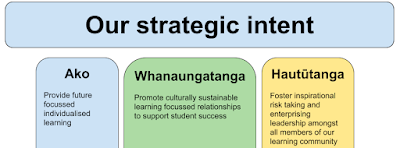Amongst the many things about Te Rito Toi that has grabbed my attention are the 'Creative Schools Index' (a central part of this paper) and the 10 dimensions of creativity that are at its core. I prefer to think of these as possible preconditions for creativity, or perhaps enablers of creativity.
The dimensions of creativity that informed the development of our research instruments are:
• Collaboration: To work in a group of two or more to develop shared understandings and achieve shared goals.
• Problem solving: To identify and articulate problems and devise strategies for their solutions and/or management considering consequences and outcomes.
• Critical thinking: To investigate the wider social and cultural context of ideas.
• Playfulness: To use imagination to create made up worlds and situations. This
capacity is often associated with enjoyment and fun.
• Environments: The qualities of the environment, including physical, emotional and
intellectual, and their adaptability for a diversity of classroom-based activities.
• Divergent thinking: To think differently about known problems; to evaluate the
knowledge students have from different perspectives and to find new ways of
understanding.
• Innovation: To realise creative ideas in tangible ways.
• Discipline knowledge: To develop expertise in a domain of knowledge that involves
specialised content and process understandings.
• Risk-taking: To be supported when trialling unconventional or previously
unconsidered approaches.
• Synthesis: To connect ideas to develop new understandings or approaches.
• Curiosity: A desire to explore, examine and understand how things are and how
things work.
Yes these are the basis for the evaluation, for the index, but more importantly they offer an insight into possible causal factors that we can intentionally influence within our kura to support and enhance creativity. This is perhaps the biggest issue for kura in general. I have for a long time held the view that teachers don't actively resist change or improvement. Rather they react to change similarly to most human beings in thinking 'yes, I get what you are saying, it makes sense when you describe it like that, but I don't know what it looks like. Show me and I'll give it a go.' These dimensions show teachers what this could look like.
It will please many of the conservatives amongst us to know that 'Discipline knowledge' is right there in the mix. Critics of NCEA have often argued that the qualification is symptomatic of the view that we no longer value knowledge. I have long argued that this is nonsense. NCEA requires deeper thinking, and you cannot think in a vacuum. You require 'stuff' to think about, specifically you require content knowledge. So in fact NCEA is a much tougher qualification than what came before ... our previous iterations of qualifications appeared to focus on remembering stuff. Under NCEA you need to know stuff AND be able to demonstrate that you can think about it .. a much tougher gig. (That's not to argue that NCEA does it perfectly, but you get the idea).
So here is one way of describing what 'it looks like'. That is, these are things that we can deliberately and intentionally target to support, to grow, creativity with our rangatahi. This rubric offers ways to think about our deliberate acts of leadership, and our deliberate acts of teaching, that make use of any of these dimensions to support creativity.
These dimensions certainly mesh well with our vision at Hornby High School, and our three areas of strategic intent, for Hornby High School.
Our vision (you will hopefully recall) is 'he puna auaha a centre of creative excellence. Our three areas of strategic intent are:
Our understanding of the need to develop an appetite for risk taking stands out as a signifiant area of commonality. I think I'll be asking our staff to self evaluate on the 10 dimensions. Not because the outcome in itself is useful, but because of the conversations that it might generate and more importantly the ways in which it might empower staff to progress towards our vision.

Kia ora Robin. I love the 10 dimesnions of creativity, something I want to explore further at our next lead meeting. I am very interested in hearing about your staff's evaluation of the the 10 dimensions.
ReplyDelete